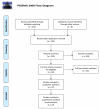COVID-19 and Liver Injury: A Systematic Review and Meta-Analysis
- PMID: 32864250
- PMCID: PMC7450889
- DOI: 10.7759/cureus.9424
COVID-19 and Liver Injury: A Systematic Review and Meta-Analysis
Abstract
Background and Aims The prevalence and extent of liver damage in coronavirus disease 2019 (COVID-19) patients remain poorly understood, primarily due to small-sized epidemiological studies with varying definitions of "liver injury". We conducted a meta-analysis to derive generalizable, well-powered estimates of liver injury prevalence in COVID-19 patients. We also aimed to assess whether liver injury prevalence is significantly greater than the baseline prevalence of chronic liver disease (CLD). Our secondary aim was to study whether the degree of liver injury was associated with the severity of COVID-19. Materials and Methods Electronic databases (PubMed and Scopus) were systematically searched in June 2020 for studies reporting the prevalence of baseline CLD and current liver injury in hospitalized COVID-19 patients. Liver injury was defined as an elevation in transaminases >3 times above the upper limit of normal. For the secondary analysis, all studies reporting mean liver enzyme levels in severe versus non-severe COVID-19 patients were included. A random-effects model was used for meta-analysis. Proportions were subjected to arcsine transformation and pooled to derive pooled proportions and corresponding 95% confidence intervals (CIs). Subgroup differences were tested for using the chi-square test and associated p-value. Means and their standard errors were pooled to derive weighted mean differences (WMDs) and corresponding 95% CIs. Results Electronic search yielded a total of 521 articles. After removal of duplicates and reviewing the full-texts of potential studies, a total of 27 studies met the inclusion criteria. Among a cohort of 8,817 patients, the prevalence of current liver injury was 15.7% (9.5%-23.0%), and this was significantly higher than the proportion of patients with a history of CLD (4.9% [2.2%-8.6%]; p < 0.001). A total of 2,900 patients in our population had severe COVID-19, and 7,184 patients had non-severe COVID-19. Serum ALT (WMD: 7.19 [4.90, 9.48]; p < 0.001; I2 = 69%), AST (WMD: 9.02 [6.89, 11.15]; p < 0.001; I2 = 73%) and bilirubin levels (WMD: 1.78 [0.86, 2.70]; p < 0.001; I2 = 82%) were significantly higher in patients with severe COVID-19 when compared to patients with non-severe disease. Albumin levels were significantly lower in patients with severe COVID-19 (WMD: -4.16 [-5.97, -2.35]; p < 0.001; I2 = 95%). Conclusions Patients with COVID-19 have a higher than expected prevalence of liver injury, and the extent of the injury is associated with the severity of the disease. Further studies are required to assess whether hepatic damage is caused by the virus, medications, or both.
Keywords: coronavirus disease 2019; covid-19; hepatic injury; liver abnormalities; liver enzymes; liver injury; liver injury biomarkers; sars-cov-2.
Copyright © 2020, Ahmed et al.
Conflict of interest statement
The authors have declared that no competing interests exist.
Figures







References
-
- Liver biochemistries in hospitalized patients with COVID‐19 [Published online ahead of print] Bloom PP, Meyerowitz EA, Reinus Z, et al. Hepatology. 2020 - PubMed
-
- Specific ACE2 expression in cholangiocytes may cause liver [Published online ahead of print] Chai X, Hu L, Zhang Y, et al. BioRxiv. 2020
-
- The PRISMA extension statement for reporting of systematic reviews incorporating network meta-analyses of health care interventions: checklist and explanations. Hutton B, Salanti G, Caldwell DM, et al. Ann Intern Med. 2015;162:777–784. - PubMed
LinkOut - more resources
Full Text Sources
Miscellaneous
